
Location, location, location! It’s not just important in real estate, it’s one of the million-dollar questions in photography. A good location can transform a so-so image into something amazing; a bad location can often destroy a great shot. In nude photography (unless you are doing close-ups of the body or there is nothing else in the background), the location is especially important.
A good location can transform a so-so image into something amazing . . .
Unfortunately, a good location can be hard to find. One of the major problems is that when you say the word “nude” people think “porn.” The more you try to explain the difference between “nude” and “porn,” the less people seem to understand it. It makes no difference whether you are photographing your wife or photographing a model—when you mix nudity with photography, things just get complex.

An image created against the wall just outside my kitchen.
When you mix nudity with photography, things just get complex.
The easiest place to start is in your home. There are many reasons why this can work very well. I have photographed nudes in every home I have ever lived in. It doesn’t matter if the house is older or newer, there is always a location where I can shoot nudes.
Advantages. When you shoot at home, you have ready access to rest rooms, private changing areas, food, and water—things that can be challenging to obtain when shooting in remote locations. Even if you rent a studio or go to a hotel for the shoot, though, you increase the chance of forgetting something. Often, it’s not even the specialized gear that turns out to be a problem when it’s omitted from your kit. When I go out to shoot, I take a case full of extra stuff (pens, clear tape, hair ties, hand cleaner, door stoppers, bandages, etc.) that can honestly make or break the session.

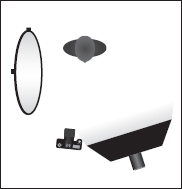
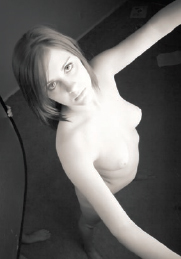
These images were created in my living room. I let the background go dark, so I didn’t need to use a backdrop of any kind. The models were lit with one strip softbox and a reflector for fill. Simple!
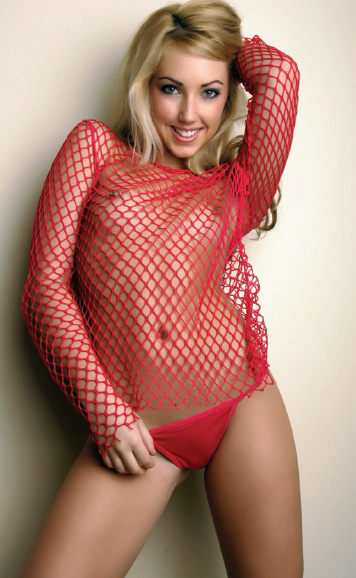
No need for rolled paper—the bottom image was shot against an off-white wall with a single softbox. In the wider view (top), you can see what the room looks like.
Disadvantages. We don’t live in a perfect world, and people are not perfect. When you shoot at home, you are inviting models (people who may be strangers to you) into your private space. While you might have many great experiences with this, eventually you will have a problem. All it takes is one bad model to cause real damage. I have heard numerous horror stories about models stealing things or showing up at a photographer’s home in the middle of the night because they got kicked out of their place and have nowhere to go. It’s also important to see this from the model’s perspective: the idea of going to some stranger’s house and getting naked in front of a camera can be intimidating.
What You’ll Need. A common practice is to convert the home’s garage into a small studio. When learning how to shoot nudes, it is important to have someplace where you can shoot repeatedly without much change. Having a controlled environment is extremely important as you’re learning. If you can shoot in one location over and over again, constantly challenging yourself to be better, you will quickly learn how to achieve good, consistent results.
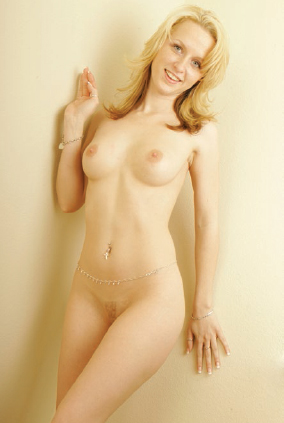
A bit of cropping can turn an image shot in a home (left) into a professional-looking portrait (right). 
![]() second, f/11, ISO 200, 24–70mm lens at 45mm.
second, f/11, ISO 200, 24–70mm lens at 45mm.
To set up a simple home studio, all you need are background stands, seamless paper, a few lights, and possibly some props.
Background stands can be found on Amazon or at your local camera store for $50 to $100. Read the reviews (if and when you can), but most background stands are similar in how they work. When it comes to the backdrops themselves, there is some debate over using cloth vs. rolled paper. Rolled paper can be expensive (it has to be replaced when it gets dirty). It’s also bulky and it takes a bit more time to work with it. Cloth, on the other hand, is a bit easier to work with and you can wash it very easily. However, inexpensive cloth backdrops (such as bed sheets) can be very hard to light correctly. Because they are so thin that light shoots through them, these fabrics generally don’t look good in photography. More expensive materials (professional backdrops) don’t seem to have this problem.
Inexpensive cloth backdrops (such as bed sheets) can be very hard to light correctly.
Overall, for someone setting up a home studio space I would suggest black or white rolled paper and a good stand. I have shot thousands of nudes on white, black, and colored rolled paper. It always looks good in the images, it’s easy to light properly, and it’s fairly inexpensive (especially if you keep it clean). Leave the sheets on the bed.
When I started out, I had a very simple setup: one strobe, a background stand, rolled paper, a reflector, and a light diffuser (a large scrim panel). Currently, such a setup would cost you $400 to $600—maybe a bit more, depending on the lights and softboxes you select. Again, this for a “starter” package. If you’re serious about studio photography, I would suggest spending whatever your budget will allow on the lights and light modifiers.
Getting Set Up. There are things you can do to make life better when shooting out of your home. First, meet the model at a coffee shop or some other public location before the session. If you (or she) has any doubts, don’t proceed. (And, of course, never discuss with models the times or dates you will be out of town!)

This portrait was shot outside the master bath.
A garage studio is just one place you can shoot at home. There are plenty of locations—I use every square inch of my house! Possible background elements to consider are: doors, windows, walls, couches, televisions, kitchens, beds, hallways, showers and bathtubs, computer desks and office areas, floors, and counter tops. I will cover backyards a bit later in this chapter.
If possible, it’s good to have a separate door for the studio part of the house. Try to restrict the shoot to one area. For example, if you have a two-story home, plan to shoot only in the downstairs area.
If you are shooting at night with photographic lights (especially strobe), keep in mind that your whole block will know what you are doing. Those lights are bright. If you have a snoopy neighbor, expect that they will look in your windows, peek over the fence into the backyard, and do anything else they can to see what you are up to. If you are shooting nudes, make sure to close off from view as much of your home as possible. If there is any chance someone will see in, don’t shoot there—change locations.
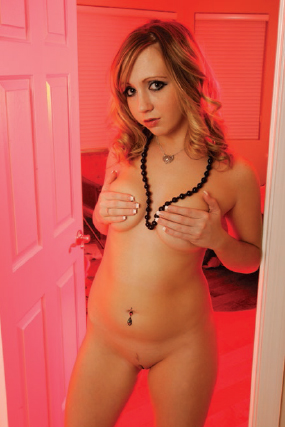
A door was used to frame the model.
This hallway leading to a guest bedroom is a great location for photographing models.
Legality. It’s time for another disclaimer: Shooting for commercial purposes (even TFP) in a hotel, motel, or other location without the owner’s or manager’s permission is illegal! I’m not encouraging you or even suggesting you ever shoot in a hotel without obtaining the correct permission and meeting the insurance requirements.
It’s always a crapshoot as to whether anyone is going to get in trouble.
Despite all of that, it would be unreasonable not to talk about shooting in hotels, since it is a relatively common practice. Some hotels don’t care; others will send security scurrying to your room if they notice anything that even remotely looks like photographic equipment. I have shot all over the western United States and in other countries—and it’s always a crapshoot as to whether anyone is going to get in trouble. I have had relatively few problems with management when shooting in hotels; I have gotten permission sometimes, and other times I have been denied permission.
Cost and Quality. Shooting in a high-end casino or hotel room can often make a model feel at ease and change the mode of the shoot. Conversely, shooting in a sleazy motel room is bound to make the model feel uneasy.


Hotel rooms offer numerous shooting areas.
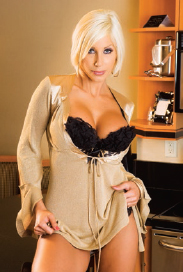
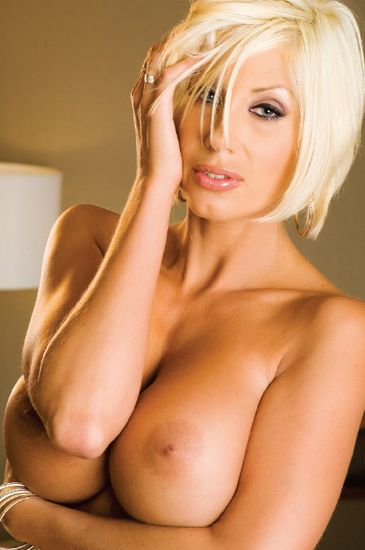
Working with two models, I created these images during a session in a hotel room.
Las Vegas, where I live, has some fantastic hotel rooms with daily rates that can run the gamut from comped (free) to tens of thousands of dollars. Many times, models will have connections on getting rooms (they may work in the hotel or have a friend that does). Sometimes, a group of photographers will go in on a room together. I’ve even ended up using a room because a visiting friend had to leave town sooner than planned.
Sometimes, a group of photographers will go in on a room together.
I keep a folder of images on my computer, showing the different hotel rooms I have shot in. I believe it is important to have a visual record of how a hotel room looks without models. This is also helpful if you want to advise visiting photographer friends on possible location selections.
If you decide to shoot in a hotel, be smart about it. I know a photographer here in Las Vegas who allowed his model to smoke marijuana in the room (two illegal things at once is really bad). Naturally, someone smelled it and called security—and when security saw the lighting gear, they freaked out and gave him the boot. Another photographer I know had the hotel bring up his photography gear—and they didn’t move fast enough for his liking, so he screamed at the bell captain and didn’t tip him. Sure enough, an hour later there was a knock at the door. Bye-bye! If you are going to do something that’s inherently sneaky, at least try to be friendly and fly under the radar.

If the hotel’s decor isn’t attractive, you can blur it by shooting wide open.
Booking the Models. If you plan to spend a day shooting in a hotel room, book more than one model—I would suggest making arrangements with four or five models. If you check in at 4:00PM, plan a model from 5:00–8:00PM, then another model from 8:00–10:00PM. The, next day schedule a session from 8:00–10:00AM, and then finally from 10:00AM to noon (or whatever checkout time is). To minimize no-shows, give the models a week or two notice and remind them frequently about the shoot. At the very least, send a reminder to each of the models the night before the shoot.
Running the Sessions. Let’s just assume the pre-planning (discussed in chapter 4) is all done. At this point, I have everything I need to shoot and all of the models booked. If I get access to the room at noon, I will get there at noon. I’ll then plan on having the makeup artist or female assistant arrive at around 12:30PM. The first model should be booked for 12:30PM or 1:00PM. (Some models consistently show up late, so I will book them for 12:30PM so I’m sure they will get there by 1:00PM.)
When I arrive at the room, I put all my gear in one location near the door. I then walk around the room and look for ideas that catch my eye. What natural light is in the room now? What will the natural light be like at sunset? Does it have large windows or small windows? What elements have bright colors? Where are there neutral colors? How big is the room? I take all these things into account as I begin to plan out a flow of shoots—from location one, to location two, and so on. Planning the right order for the locations means I can simply rotate my lights around 180 degrees and get a completely new look and feel without having to drag my gear all over the room and back again.

Colorful areas of the hotel room make eye-catching settings for models.
I can simply rotate my lights around 180 degrees and get a completely new look.
Finally, I find a safe location (out of the path of foot traffic) to use as a staging area for my camera gear, lenses, and other items I will need while I work. Anything I don’t plan on using during this shoot (extra camera, my wallet, etc.) gets hidden away in a closet. I then set something in front of the closet door so it can’t be opened easily.
If you are shooting at night, close the blinds. Trust me, in a huge high-rise hotel it is really clear when someone is shooting. A security guard can simply stand on the ground floor and look up at the building. If they see flashes going off, they will be knocking on your door a few minutes later.
Photographers often rent studios to get better at photography—but sometimes they end up getting even worse at it. A studio can be a really useful tool if you know what you are doing and have the time and money to do it right. When you rent a studio, however, you are often paying by the hour. As a result, many photographers make the fatal mistake of rushing to get as many shots as possible. They don’t take the time to set up their lights and gear properly—and what can you expect to learn by taking a thousand poorly lit shots of a model? If you decide to rent a studio, take your time. Set up the lighting and gear carefully, help the model with posing, control the environment as much as you can, and then do your best. A hundred good shots is far better than a thousand lousy ones.
One of the suggestions I would make is to talk to the studio’s owner and see if you can work out a trade. Maybe you could assist them at their shoots or provide some Photoshop work in return for the use of their studio. Agreements like this are not uncommon; professional photographers are really busy all the time. If the studio is free, many will let other artists use it if they can figure out how to save themselves some money in the long run.
Talk to the studio’s owner and see if you can work out a trade.
An additional problem with renting a studio is that most professional studios are not designed for nude photography. Many of the common portrait photography sets look strange with nude models. Additionally, some models don’t feel comfortable working nude in a studio when they don’t know how clean it is or how many other people have been there.
Ultimately, working in a professional studio is just a more expensive solution to many of the same problems we’ve already addressed when shooting at hotels and houses. For most of us, there are more cost-effective ways to create our images.
I see great locations used for weddings or glamor photography that would be perfect for a nude shoot, but I know I’d be the one to get in trouble if I tried it! Each state has different laws about public nudity and how much trouble the photographer or model can get into, but let’s assume it is illegal everywhere.

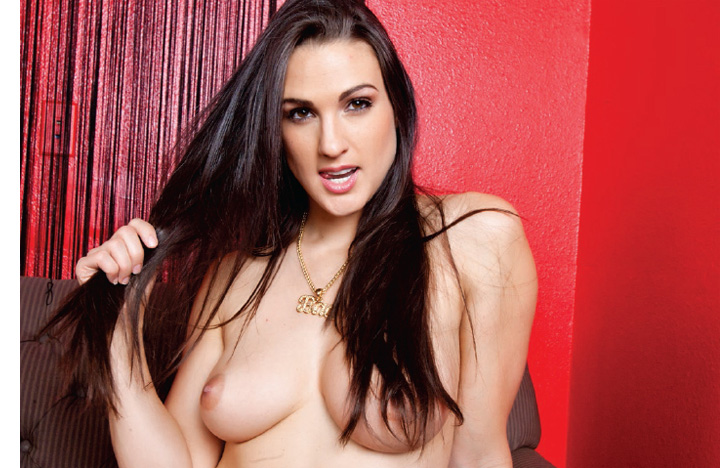
If you take your time and think about what you’re doing, your studio rental dollars can pay off in nice images.
Risk vs. Reward. Before using a location, you should do some scouting without the model. If you find a place that you think is good, spend a little time observing the area. How busy is it?
When shooting out in public, you have to balance the risk against the reward.
How dangerous is it? Do you need a permit to shoot there (if it is a state park, you just might)? You may also want to try doing a non-nude shoot at the location first. If you don’t have any problems, then you can try a nude shoot there.
When shooting out in public, you have to balance the risk against the reward. How great is the image going to be? How much risk is there? For example, I have been asked by many different companies to shoot their model naked in front of the famous “Welcome to Las Vegas” sign (they think it will be good PR, I guess). The sign is a block away from a police station and always busy with tourists, so the risk is very high that someone will call the police or complain. The last company to request this location was a jeans designer who wanted me to shoot a topless model wearing their product. For me, the risk wasn’t worth the reward, so I had to pass.
Fortunately, there are many locations in my area with much lower risk factors (and, in my opinion, they also look much cooler and less cheesy than the Vegas sign!).
If at all possible, I urge you to scout the location carefully before doing a real nude shoot there. If you can’t test the location first, set everything up, shoot, and leave—quickly. The longer you are there (setting up, talking, or goofing off), the greater the chance that you will get into trouble. It’s also a good idea to station friends nearby as lookouts (and they can be called in to do double-duty holding a reflector). On a shoot in Mexico, we hired the hotel security guards to look out for the local beach police. We paid them $10 or $20 for a few hours of work and they got to see naked girls. It worked great!
Location Scouting: A True Story
My wife and I found a killer location that overlooks the whole Las Vegas valley and is just a few minutes from our house. No one lives too close and it’s on a straight road, so I can see anyone coming well before they could get to us. This gave it a lot of potential as a shooting location.
Our plan of action was to start by shooting some cityscapes—just some pretty pictures of Las Vegas. If we had no problems, we’d proceed to photograph a girl in a vintage showgirl costume, overlooking the city. Assuming that went well, the ultimate concept was to create a nude image depicting a crying girl running away from Sin City—as if the sin in the city had completely stripped her.
We drove to the spot and didn’t see any no-trespassing signs, so we set up the camera and started shooting panoramics of the city as the sun was going down. We didn’t anticipate any problems; we weren’t using any flashes and there were no models with us. However, we were there for no more than fifteen minutes when a security guard from a nearby park drove over and to see what we were doing. He wanted to make sure we didn’t have a flat tire or some other car problem—then proceeded to chat with us about the local water shortage for over an hour. The nice, chatty security guard also told me there is always someone around because they are building in the area and part of the contract requires security on the site. You can learn a lot from a chatty security guard; I learned that this location was out of the question for photographing nudes.
Working quickly can help you escape notice, but there are always risks associated when shooting nude images in public.
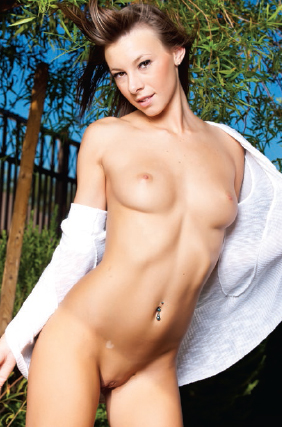
These images were shot in my backyard using one strobe.
In Las Vegas, the houses are right on top of each other. However, I still love shooting in my own backyard or in friends’ backyards. The following are some things to consider.
Can Anyone See the Shoot? It doesn’t matter whether or not it is your right to be naked in your backyard, if someone can see you, I wouldn’t do it. If your neighbors (or your neighbor’s kids) can see you, they are going to complain. And, let’s face it, photographing naked models in your backyard is a bit different than occasionally hanging out nude in your hot tub. Don’t push your luck.
Consider All the Options. If you have a private backyard, use it to full effect. If you need to, buy some 100-foot power cords and drag a light with a softbox a few hundred feet away from you house. Shoot on your knees. Shoot up at the sky. Place a model in front of a tree (most trees look great with a nude model in front of them). Outdoor images, to me, look much less contrived than indoor ones—and these shoots tend to be a lot of fun for the model.
No Pool? No Worries. None of my houses have had a pool or fancy landscaping. In fact, showing expensive landscaping in the background can make your work look more like high-end glamour portraits than fine-art nudes. Often, it is the simpler, more natural backgrounds that work best, so don’t worry if your backyard isn’t perfect. Just shoot at different times of the day and see how the light hits the landscape, the trees, the plants, the models, etc.
Private backyards are ideal for shooting nude photography.
Often, it is the simpler, more natural backgrounds that work best.
Whether or not the risks are too high at a given location is something you and your model will have to determine for yourselves.
Outdoors: Parks and Public Lands
Again, shooting nudes in public is almost always illegal. It doesn’t matter if it is just a topless picture of your wife or some great landscape with a professional model overlooking the Grand Canyon—it’s illegal.
The only legal way to shoot nudes at a park is to get a license and to be honest about what you will be photographing (nude photography). You must also carry the required insurance.
Clothing-Optional Areas. Some parks have designated clothing-optional areas at hot springs, beaches, or other remote areas. Does that mean you can shoot nude images? Most likely not. You can still get hassled by police or park rangers, so I generally try to stay away from those areas.
Be Prepared. If people see you shooting nude models in a public area, they will generally assume you are creating pornography—even if the girl isn’t completely naked or doing anything sexually suggestive. In some cases, they will watch for a minute and then walk away and tell no one. In other cases, they will come over and say hello. Sometimes, though, they will leave and notify the authorities.
If you get busted, you can face thousands of dollars in fines and possibly lose some of your gear (park rangers can confiscate your camera and/or memory cards). The model can also get into trouble for her role in the shoot, so make sure she knows what she’s getting into before you head out for the session. Everyone has their own idea of what constitutes an acceptable risk. Whether or not those risks are too high at a given location is just something you and your model will have to determine for yourselves.
How to Shoot. Let’s assume you find some safe, private place—something a short walk away from where you parked. You and the model feel it’s safe to shoot. How do you do it?
Once I find a location and lighting I like, I get everything in order, making sure the model is ready. For the shoot, I request the model wear loose-fitting clothing that can be taken on and off quickly and won’t leave indentations on her body (such as from bra straps or snug waistbands).
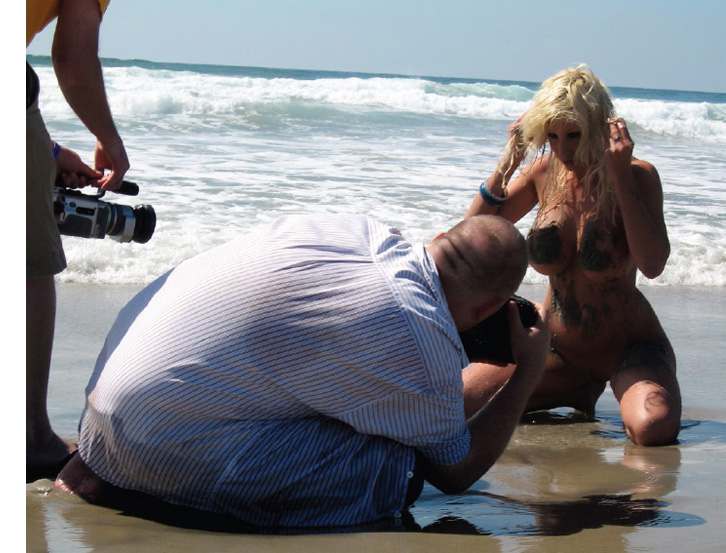
When shooting outdoors in public areas, choose your location wisely and work quickly. This is me photographing Puma Swede on a beach in Mexico for a magazine. Notice that I added no lights or reflectors—it was just a camera and a model. To see one of the final images from this session, turn to page 40.
Make sure the model understands the risks and rewards of an outdoor shoot.
With the model still clothed, I do a few test shots, making sure my exposure is right and that the person working the reflector (and providing an extra set of eyes as a lookout) is in the correct position. Then, if needed, I go over some basic poses with the model.
With the model still clothed, I do a few test shots, making sure my exposure is right . . .
Finally, I will have the model remove her clothing and tuck it in a safe place for her (put a rock on her garments or place them in your camera bag). Then, I start shooting as quickly as I feel is possible. I will remind everyone to be on the lookout for people and to remind me when five or ten minutes has passed. (When I shoot, I lose track of time very easily because I am focused on the light and the model, so it helps when another person keeps track of the time for me.)
As I shoot, I try to look at the LCD only one or two times; constantly checking it will only slow down the shoot. When I feel I have captured some images I like (or if we sense that people are getting too close), I have the model get dressed and we move on to the next location.